
The national flag of Poland consists of two horizontal stripes of equal width, the upper one white and the lower one red. The two colours are defined in the Polish constitution as the national colours. A variant of the flag with the national coat of arms in the middle of the white fess is legally reserved for official use abroad and at sea. A similar flag with the addition of a white eagle is used as the naval ensign of Poland.

The coat of arms of Poland is a white, crowned eagle with a golden beak and talons, on a red background.

The Constitution of the Republic of Poland is the supreme law of the Republic of Poland, which is also commonly called the Third Polish Republic in contrast with the preceding systems.
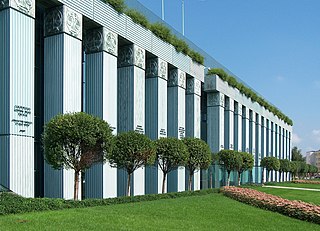
The Supreme Court is the highest court in the Republic of Poland. It is located in the Krasiński Square, Warsaw.

The Constitutional Tribunal is the constitutional court of the Republic of Poland, a judicial body established to resolve disputes on the constitutionality of the activities of state institutions; its main task is to supervise the compliance of statutory law with the Constitution of the Republic of Poland.
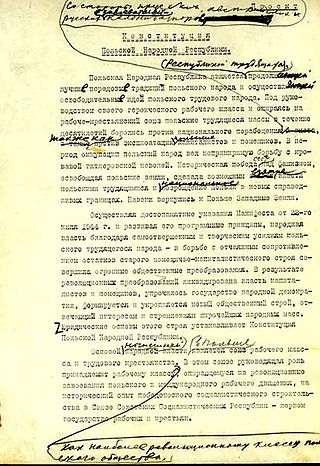
The Constitution of the Polish People's Republic was a supreme law passed in communist-ruled Poland on 22 July 1952. It superseded the post-World War II provisional Small Constitution of 1947, which in turn replaced the pre-war April Constitution of 1935.

Ministry of the Interior and Administration is an administration structure controlling main administration and security branches of the Polish government. After Parliamentary Election on 9 October 2011 was transformed for two ministries: Ministry of Interior and Ministry of Administration and Digitization. It was recreated in late 2015.

God, Honour, Fatherland or Honour and Fatherland is one of the unofficial mottos of Poland. It is commonly seen as the motto of the military of Poland, and has been confirmed as such by several Polish legal decrees.
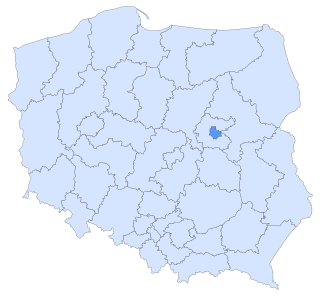
Warsaw I, officially known as Constituency no. 19, is one of the 41 constituencies of the Sejm, the lower house of the Parliament of Poland, the national legislature of Poland. The constituency was established as Constituency no. 1 in 1991 following the re-organisation of constituencies across Poland. It was renamed Sejm Constituency no. 19 in 2001 following another nationwide re-organisation of constituencies. It is conterminous with the city of Warsaw. Electors living abroad or working aboard ships and oil rigs are included in this constituency. The constituency currently elects 20 of the 460 members of the Sejm using the open party-list proportional representation electoral system. At the 2023 parliamentary election it had 1,993,723 registered electors.
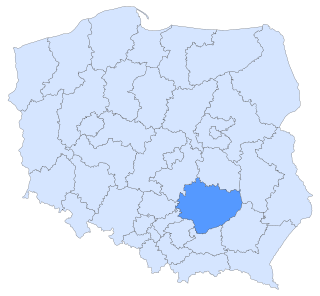
Sejm Constituency no. 33 is a constituency of the Sejm encompassing entire Świętokrzyskie Voivodeship and ellecting sixteen deputies. Constituency seat is voivodeship's capital Kielce.

Sejm Constituency no. 21 is a constituency of the Sejm electing twelve deputies. It consists of entire Opole Voivodeship. Constituency Electoral Commission's seat is voivodeship's capital, city of Opole.

The Bulletin of Public Information is a Polish system of unified public records online, consisting of an array of standardized pages created with the general public in mind. For those interested in the operation of any particular institution in Poland or in finding a way of contacting them in order to settle a particular matter, the BIP given entry is often the optimal source of data and background information. The offices of BIP are located at Królewska 27 Street in Warsaw. Its Editor-in-chief is Tadeusz Mąkosa.
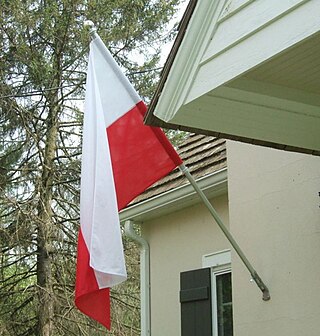
The Polish National Flag Day, also known as the Day of the Flag of the Republic of Poland, is a national holiday in Poland which takes place on 2 May every year. The holiday is celebrated on the day between two national holidays: 1 May and 3 May

Civil Administration of the Eastern Lands was a civil authority of the territories controlled by Second Polish Republic but not incorporated into the state itself, that was formed during the Polish–Soviet War in 1919 and existed until 1920. It was formed on 19 February 1919 from the territories taken by Poland during the war, that were previously occupied by the Russian SFSR. In the summer of 1920, forces of Russian SFSR had conquered the area. After part of the area was reconquered by Poland, the administration was formally disestablished on 9 September 1920, and replaced by the Provisional Administration of Front-line and Phase Territories.

The Polish National Agency for Academic Exchange is a governmental agency in Poland established to carry out tasks related to the academic mobility between Poland and other countries. Since November 2018 the agency is part of Academic Cooperation Association. It primarily provides grants to individuals and organizations rather than through its own staff.

National road 37 is a main road (Polish: droga główna, droga klasy G) route belonging to Polish national roads network, located in West Pomeranian Voivodeship. With its length of 14.6 kilometres (9.1 mi), the route connects the town of Darłowo with national road 6 near Karwice. In the future a new junction will be constructed, linking road 37 with expressway S6.

National road 96 is a main road of accelerated traffic, belonging to Polish national roads network, with length of 1.5 kilometres (0.93 mi) and located in Toruń County. It connects motorway A1 with national road 15. With its length, the route is the shortest one of all national roads in Poland.

















